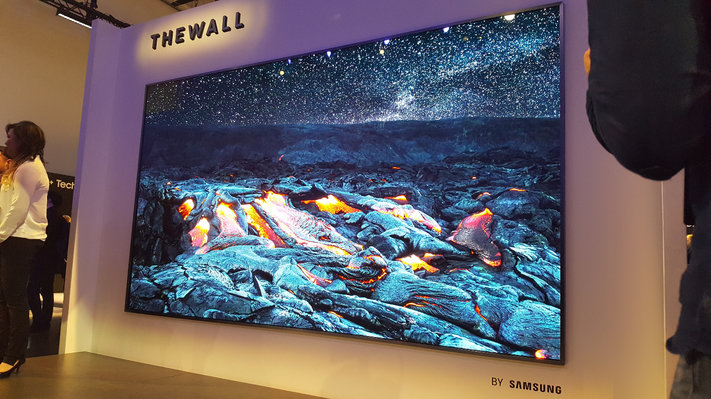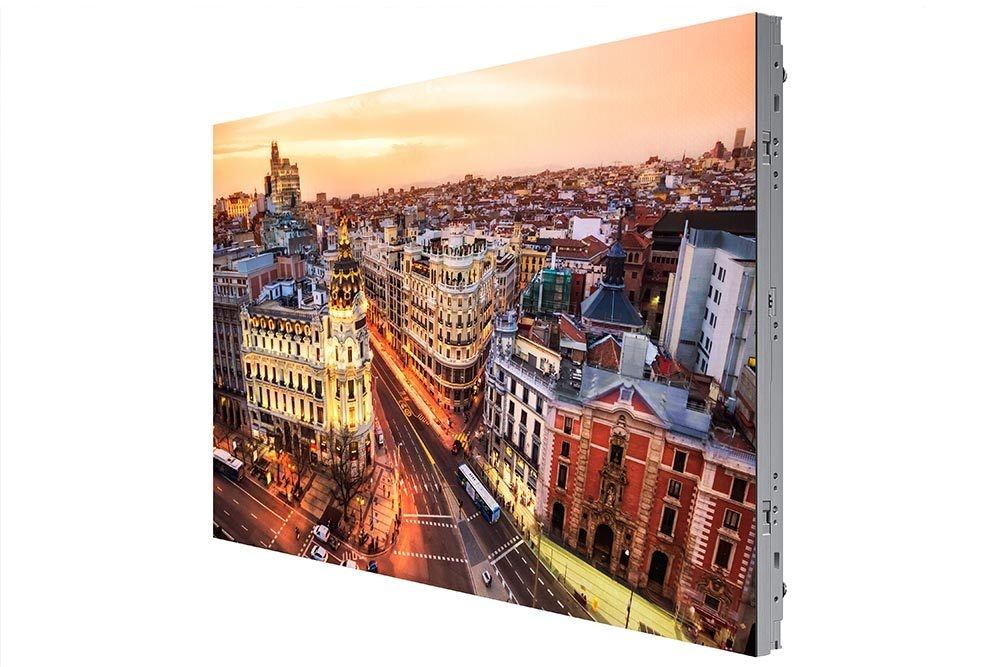Samsung's 146-inch The Wall TV Is Now Available for Order
The jaw-dropping, modular MicroLED set can be purchased now, but the price is even bigger than the TV.
Samsung's gigantic "The Wall" TV is now available for purchase. Available in sizes up to 292 inches, it's the biggest TV you can buy, and the only set on the market to offer Samsung's microLED technology, which uses super-fine LEDs to provide light and color for individual pixels.
About the only thing larger than the wall-sized TV, however, may be the price, with individual panels priced at more than $16,000 each, and multiple panels needed to make a single screen with 4K resolution.

The Wall TV can be configured to sizes ranging from 146 inches to 292 inches diagonally and uses MicroLED technology instead of OLED or traditional LED. MicroLED delivers many of the benefits you'll find in OLED, including perfect blacks and eye-popping colors, but the set also boasts 1,600 nits of brightness. That's brighter than today's OLED sets.
At CES 2019 Samsung showed off two new versions of this MicroLED technology. The first was an even larger version of The Wall, stretching the massive TV from the 146-inches we saw in 2018 to a jaw-dropping 219 inches. Because The Wall is made up of borderless tiles, the modular design allows additional tiles to be added, making this even-bigger version of The Wall possible.
But there was also a more reasonable take on the technology, with a 75-inch model called The Window. The TV boasts a refined version of MicroLED that fits more LEDs into smaller modular tiles, allowing the TV to offer 4K resolution in the 75-inch size. It also offers all of the same unique configurations offered on the larger model, with Samsung boasting that the TV would support a variety of aspect ratios beyond the traditional 16:9, and can scale the resolution and aspect ratio to whatever will look best on your unique setup. While we're still waiting on pricing and availability details, the 75-inch version puts MicroLED technology into a size that may actually make it into your living room.
Another key benefit of The Wall is that it's modular, so you can take part of it and move it around and get the exact screen size you want — a handy benefit of MicroLED.
Samsung is touting The Wall and MicroLED specifically as the future of television technology. But one of the problems with MicroLED is that it's difficult to produce, and its true benefits are best seen in really big screens.
Sign up to get the BEST of Tom's Guide direct to your inbox.
Get instant access to breaking news, the hottest reviews, great deals and helpful tips.

Currently, Samsung is offering two models of The Wall, or rather the individual panels that make up The Wall, the IW008J and the IW008R. While Samsung doesn't list prices for these panels online, other resellers are listing the modules for $16 to $23 thousand dollars each.
These individual modules measure 31.75 x 17.86 inches, but have an individual resolution of 960 x 540 pixels. In order to enjoy the same 3840 x 2160 resolution you'll get on a standard 4K TV, you'll need to buy 16 of these panels, to set up in a 4 x 4 configuration that measures 146 inches diagonally.
If you're in the market for a microLED TV, and are comfortable spending upwards of $300,000 to get the same 4K resolution that the best cheap 4K TVs provide, you'll need to contact Samsung directly to order products and arrange custom installation.
For something higher than 4K resolution, approaching the likes of the Samsung 8K Q900R QLED TV, you'll need to go even larger, to the 6x6 configuration. While this still won't give you the full 8K resolution that you can get in stores now, it does measure a whopping 219 inches. Again, you'll need to contact Samsung directly for a quote, but you can check out your own possible setups using Samsung's configurator tool.
Brian Westover is currently Lead Analyst, PCs and Hardware at PCMag. Until recently, however, he was Senior Editor at Tom's Guide, where he led the site's TV coverage for several years, reviewing scores of sets and writing about everything from 8K to HDR to HDMI 2.1. He also put his computing knowledge to good use by reviewing many PCs and Mac devices, and also led our router and home networking coverage. Prior to joining Tom's Guide, he wrote for TopTenReviews and PCMag.
-
basherssuck this is retarded to spend 100k on a tv, i got a 4k optoma projector that can be controlled by amazon alexa for $1350 on the week of black friday no tax from b&h photo website, delivered in a few days. i have a 180 inch screen i bought from amazon website for $100. for $1450 total i have a bigger image than that tv and the projector is 4k and has smooth motion built in where i can get the movement fluid like how it looked on the hobbit movie that was shown in 48 frames per second in special theaters. and i can watch during the dayReply

